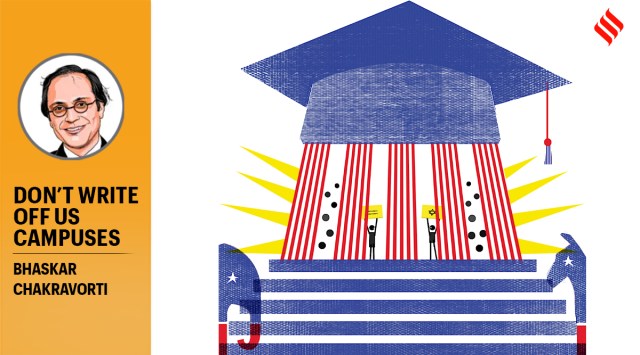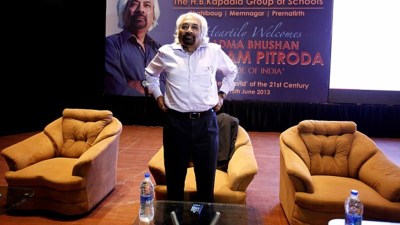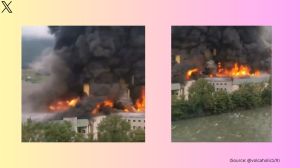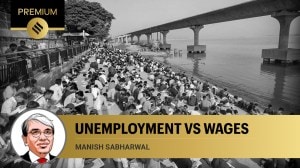- India
- International
US campus crises: Are America and a fragile world order at risk of coming apart?
Of all places, US universities are better equipped to withstand the collision of ideas, clashing groups, and opposing worldviews than most other institutions. But the divisions beyond the gates of the campus have created the perfect breeding ground for political bottom-feeders
 Demonstrators face off with NYPD officials outside the main entrance of Columbia University, as they stand in solidarity with the ongoing protests in support of Palestinians happening on the university campus, in New York City, U.S., April 24, 2024. (Photo: REUTERS)
Demonstrators face off with NYPD officials outside the main entrance of Columbia University, as they stand in solidarity with the ongoing protests in support of Palestinians happening on the university campus, in New York City, U.S., April 24, 2024. (Photo: REUTERS)Are America’s enviable institutions of higher learning coming apart? Viral videos of duelling student groups, police handcuffing protestors across campus quads and a parade of university presidents laid low by a single combative Republican legislator suggest a crisis of monumental proportions.
Before we write them off, remember, we have been on these troubled quads before. Consider April 23, 1968. The United States was still reeling from the assassination of Martin Luther King Jr. and many parts of the country — especially Harlem, the neighbourhood around Columbia University — was a tinderbox. The campus, normally an island of calm with the madness of Manhattan just outside its wrought-iron gates, was anything but calm. Community activists opposing the building of a racially segregated university gym in Morningside Park abutting the campus joined hands with a student group that had taken issue with Columbia’s connections with a think tank conducting weapons research for the Vietnam War. They ended up occupying five campus buildings and taking a dean hostage. On April 30, New York City police moved in to clear the occupied buildings. Arrests, violence, and suspensions followed, and the university closed for the balance of the academic year. Columbia inspired protests elsewhere, on and off campuses. Robert F Kennedy, the leading candidate for president from the Democratic party was assassinated in June, followed by anti-war riots at the Democratic National Convention in August. The cumulative effect was a backlash against chaos. The “law and order” Republican candidate, Richard Nixon, was elected president later that year.
Now, here we are in April 2024. Columbia’s South Lawn looks about the same as it did 56 years ago, with students parked on it once again. And once again, the New York City police moved in, and arrested and removed students. The students were protesting the flattening of Gaza by Israel and the deaths of over 34,000 people, mostly innocent civilians. Israel was responding to the brutal attack by Hamas on its citizens on October 7, last year. Jewish students on campus were feeling threatened by the protests and feared a return of anti-Semitism. Pro-Palestinian students felt their voices were shut down more often by the administration. Just the day before, Columbia’s president, Minouche Shafik, had committed to countering acts of anti-Semitism on campus; a swift invitation to the police to clear the grounds seemed like her way of showing she meant it. Now, protests in solidarity with Columbia students have broken out on campuses across the country, including my own.
While we can legitimately worry about the state of American universities, I have confidence in their resilience. Of all places, they are better equipped to withstand the collision of ideas, clashing groups, and opposing worldviews than most other institutions; and this is despite the evidence of groupthink and “cancel culture” at far too many top universities. In the aftermath of 1968, Columbia suffered a decline in applications and funding, but today many kids would sell their parents to attend the school and the university makes enough to build a $600 million campus for its business school. US universities are still places where breakthrough discoveries happen and there are instructors who are legends in the classroom. I am far less sanguine about the larger story unfolding beyond the quad and the wrought-iron gates.
For one, anger is rising over the cascading events in the Middle East within and beyond the university. Acts of hate have spiked: Complaints over both anti-Semitic acts and anti-Muslim incidents have gone up dramatically. The American Left has splintered. In a country that religiously upholds the right to freedom of speech many are self-censoring or speaking in hushed whispers for fear of offending others or being called out by one group or another.

This atmosphere offers a perfect breeding ground for political bottom-feeders. There are many of these, as America is gearing up for a presidential election in November. The ghosts of the 1968 elections sit at this year’s electoral table as well. Of course, 1968 was an exceptional year in the US. Amidst a sense of chaos, far too many in the Democratic base chose not to turn up to vote and Nixon won with the clarity of his message. Also, Hubert Humphrey, the Democratic candidate and supporter of the Vietnam war alienated the Democratic base, especially the campus protestors.
We find ourselves, again, in an exceptional year. Donald Trump, the presumptive Republican candidate is juggling a criminal trial and 91 felony counts. He is looking to unseat the incumbent Joe Biden, who can point to more legislative accomplishments than most other presidents in recent memory, but is also the recipient of the lowest approval rating of any other first-term president besides Jimmy Carter. Once again, Trump’s message is so clear he can wear it on a hat and its four-letter acronym, MAGA, is his entire vision for America. Biden’s message cannot fit on a hat. His age turns off young voters. His support of the war in Gaza has alienated many in the Democratic base. And yes, that includes those campus protestors.
So, instead of fretting over whether America’s celebrated institutions of higher learning are coming apart, we ought to ask a more critical question: Are America and an already fragile world order at risk of coming apart? Imagine a Trump presidency 2.0 alongside the famine and flattening of Gaza, the fanning of flames across the Middle East, with war raging in Ukraine and a sword dangling over Taiwan. The world may not be resilient enough to survive two rounds of Trump. If Nixon left a permanent scar, Trump will leave a perpetually open wound.
We need to find a resolution to the crisis in Gaza and Israel not so much to save America’s universities but to prevent further loss of innocent lives, to save America itself and the global order that hinges on the country not being led by an unhinged man. With a Trump return, campus protestors will have much more to protest about.
The writer is Dean of Global Business at The Fletcher School at Tufts University
EXPRESS OPINION
More Explained
May 09: Latest News
- 01
- 02
- 03
- 04
- 05
































